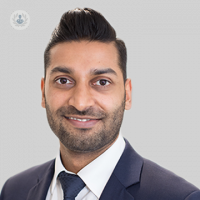Treatment for benign prostatic hyperplasia: an expert’s guide
Escrito por:Benign prostatic hyperplasia (BPH) stands as a prevalent urological issue among males, impacting an estimated 3 million individuals in the UK each year. Distinguished consultant urological surgeon Mr Sachin Malde provides a guide to the various treatment options that he offers at his clinic.

What are the latest and most effective treatments for benign prostate enlargement?
Benign prostate enlargement, also known as benign prostatic hyperplasia (BPH), is a common condition affecting men as they age. This non-cancerous enlargement of the prostate gland can lead to bothersome urinary symptoms, impacting quality of life.
Revolutionary treatments:
There are several revolutionary treatments available for benign prostatic hyperplasia, including the following:
UroLift®
UroLift® is a revolutionary, minimally invasive procedure designed to relieve the symptoms of BPH without the need for traditional surgery. This technique is employed to lift and hold the enlarged prostate tissue, creating an unobstructed pathway for urine flow. This outpatient procedure is performed with precision, offering rapid relief from urinary symptoms, minimal downtime, and preserving sexual function.
Rezūm
Harnessing the power of water vapour therapy, Rezūm is a state-of-the-art treatment that targets and shrinks the obstructive prostate tissue. Mr Malde utilises Rezūm to provide a quick and efficient solution for patients seeking relief from BPH symptoms. This innovative approach boasts a short recovery time, significantly reducing the impact on daily life.
Aquablation
Aquablation, the latest groundbreaking technique in Mr Malde's arsenal, utilizes a robotically controlled waterjet to precisely remove excess prostate tissue. This advanced procedure combines the accuracy of robotics with the gentleness of water, ensuring excellent outcomes whilst minimising complications. Patients can experience a faster recovery and maintain their sexual function post-treatment.
Are there non-surgical options available for treating an enlarged prostate?
Yes, there are non-surgical options available for treating an enlarged prostate, especially in the early stages of benign prostatic hyperplasia (BPH). These non-surgical approaches aim to alleviate symptoms and improve the quality of life without the need for invasive procedures. Here are some common non-surgical options:
Medications:
Alpha-blockers: These drugs relax the muscles around the prostate and bladder neck, improving urine flow and relieving symptoms like frequent urination and urgency.
5-Alpha reductase inhibitors: These medications work by reducing the size of the prostate gland, helping to alleviate symptoms over time. They are particularly effective for larger prostates.
Lifestyle Modifications:
Diet and Exercise: Maintaining a healthy lifestyle, including regular exercise and a balanced diet, can help manage BPH symptoms.
Limiting fluid intake before bed: This can reduce the frequency of nighttime urination.
The choice of treatment depends on the severity of symptoms, the size of the prostate, and the patient's preferences. I provide state-of-the-art diagnostics to understand the cause of a patient’s symptoms, and discuss all treatment options with patients so that a treatment can be found that fits with each individual situation.
What are the potential side effects of the latest treatments for BPH?
The latest minimally-invasive treatments for BPH have fewer complication rates than traditional surgery. Men can expect to preserve sexual function in most cases, with small risks of bleeding or urinary tract infection which are common to all procedures on the prostate. However, the overall side effect rates are low, and the appropriateness of these new minimally-invasive treatments will be discussed with you based on your specific circumstances.
What advancements in minimally invasive procedures are being utilised for the treatment of benign prostate enlargement?
The latest advancement is the use of robotic surgery with a procedure known as Aquablation. I am one of the few experts in the UK performing this technique which gives excellent improvements in urinary symptoms, whilst also minimising the complications on sexual function or incontinence that are often associated with the traditional surgical techniques. The use of robotic surgery allows for very precise treatment that can be planned specifically based on the shape of the prostate, and so can offer a very personalised treatment approach.
If you would like to book a consultation with Mr Malde, do not hesitate to do so by visiting his Top Doctors profile today.


